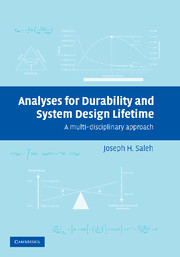Book contents
- Frontmatter
- Contents
- Preface
- 1 Introduction: On Time
- 2 To Reduce or to Extend Durability? A Qualitative Discussion of Issues at Stake
- 3 A Brief History of Economic Thought on Durability
- 4 Analysis of Marginal Cost of Durability and System Cost per Day
- 5 Flawed Metrics: System Cost per Day and Cost per Payload
- 6 Durability Choice and Optimal Design Lifetime for Complex Engineering Systems
- EPILOGUE: Perspectives in Design: The Deacon's Masterpiece and Hundred-Year Aircraft, Spacecraft, and Other Complex Engineering Systems
- APPENDIX A Beyond Cost Models, System Utility or Revenue Models: Example of a Communications Satellite
- APPENDIX B On Durability and Economic Depreciation
- Index
- References
6 - Durability Choice and Optimal Design Lifetime for Complex Engineering Systems
Published online by Cambridge University Press: 25 October 2009
- Frontmatter
- Contents
- Preface
- 1 Introduction: On Time
- 2 To Reduce or to Extend Durability? A Qualitative Discussion of Issues at Stake
- 3 A Brief History of Economic Thought on Durability
- 4 Analysis of Marginal Cost of Durability and System Cost per Day
- 5 Flawed Metrics: System Cost per Day and Cost per Payload
- 6 Durability Choice and Optimal Design Lifetime for Complex Engineering Systems
- EPILOGUE: Perspectives in Design: The Deacon's Masterpiece and Hundred-Year Aircraft, Spacecraft, and Other Complex Engineering Systems
- APPENDIX A Beyond Cost Models, System Utility or Revenue Models: Example of a Communications Satellite
- APPENDIX B On Durability and Economic Depreciation
- Index
- References
Summary
PREVIEW AND GUIDE TO THE CHAPTER
This chapter addresses the durability choice problem for complex engineering systems, as seen from the customer's perspective and in the face of network externalities and obsolescence effects. Economists have investigated the impact of market structure on manufacturers' durability choices (under monopolistic or competitive market conditions); this chapter departs from the literature on the subject by addressing the durability choice problem from the customer's perspective, and an “optimal” durability is sought that maximizes the NPV of an asset for the customer (as opposed to maximizing the profits of the manufacturer). First, the various qualitative implications for reducing or extending a product's durability are discussed. Second, analytical results for the optimal durability are derived under steady-state and deterministic assumptions. Trends and functional dependence of the optimal durability on various parameters are identified and discussed. Third, the durability choice problem is explored when the risk of obsolescence is accounted for. Finally, the durability choice problem under uncertainty is investigated and the various risks in making cautious or risky choices of durability are discussed.
Introduction: A Topic Overlooked by Economists and Engineers
The objective of this chapter is to contribute an analytical framework toward the rational choice of durability for engineering systems, as seen from a customer's perspective, and in the face of network externalities and obsolescence effects.
- Type
- Chapter
- Information
- Analyses for Durability and System Design LifetimeA Multidisciplinary Approach, pp. 101 - 127Publisher: Cambridge University PressPrint publication year: 2007



